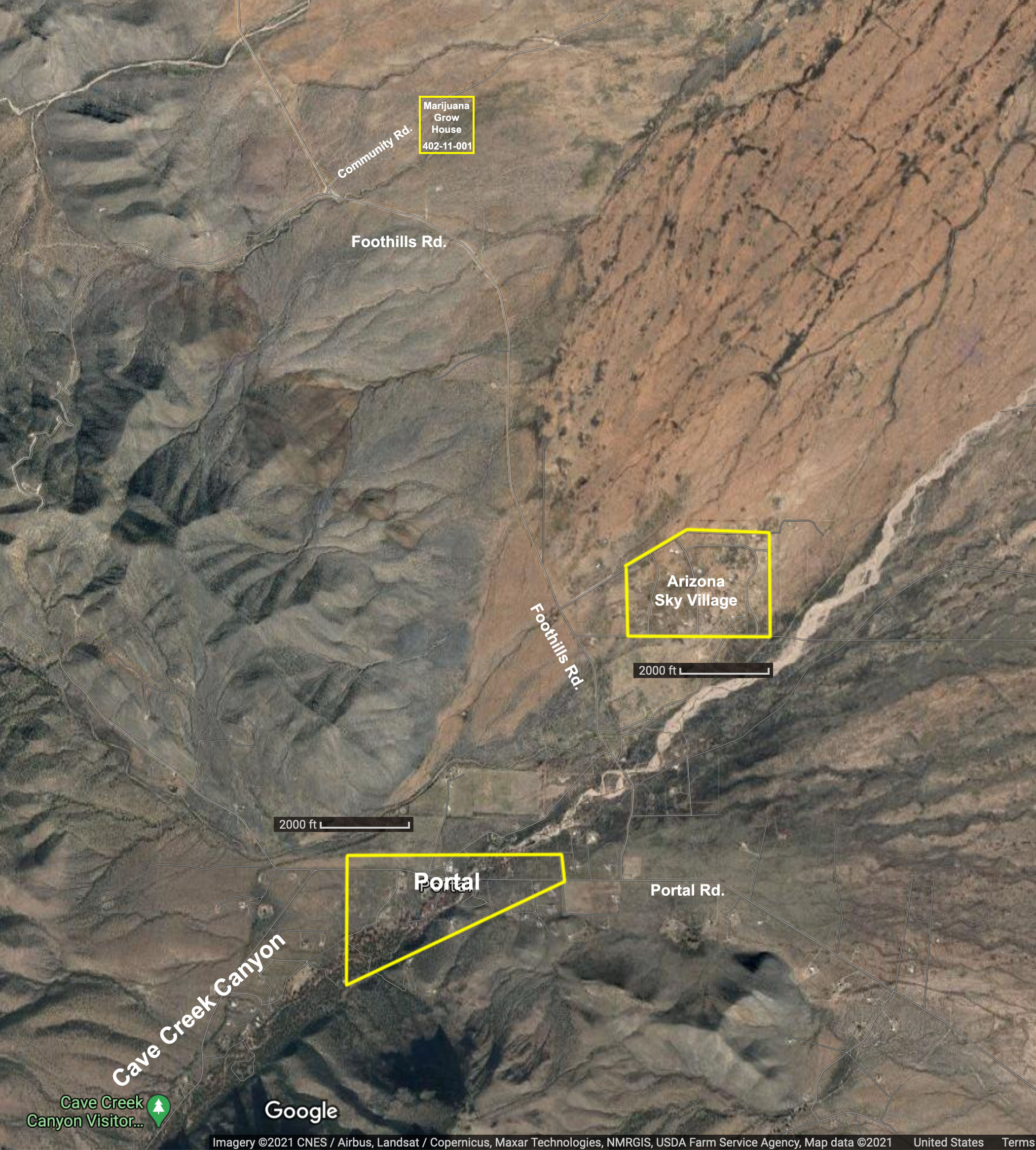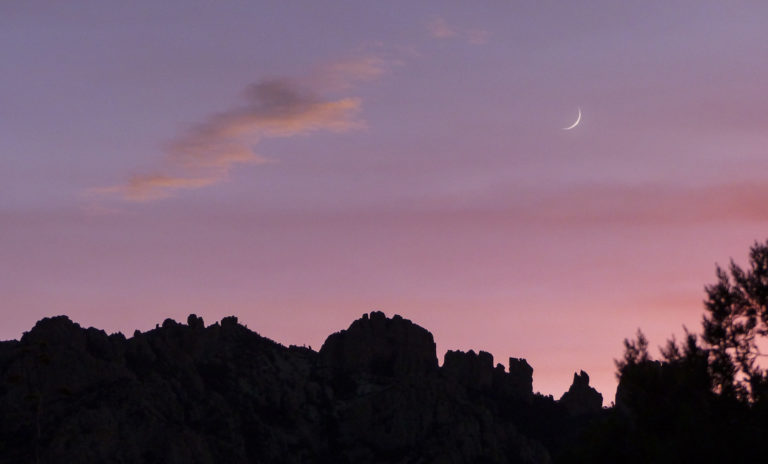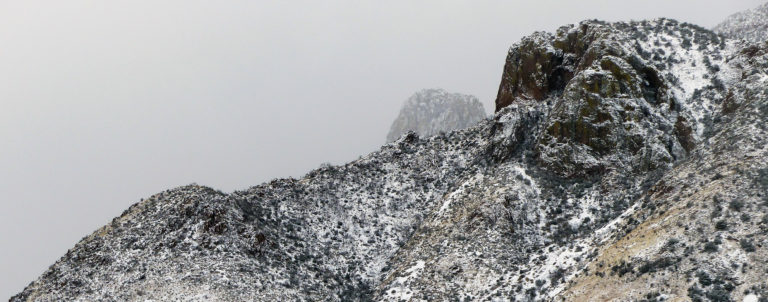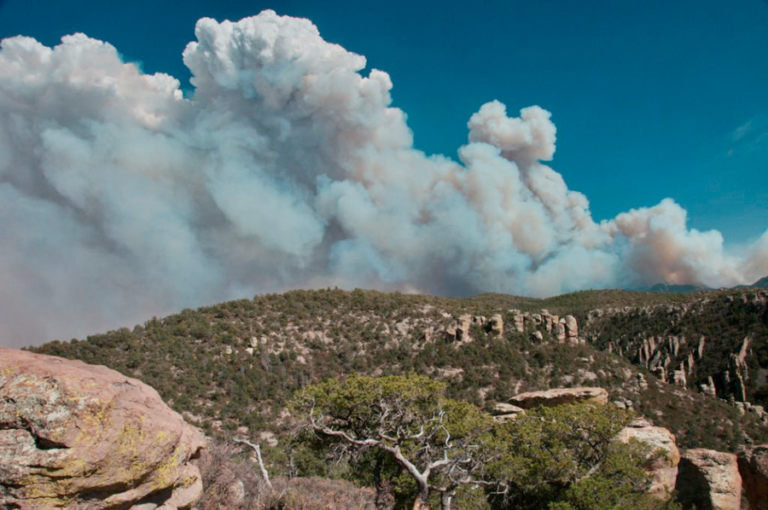CRC Comments on Proposed Marijuana Grow Facility
In February 2021, Jeffrey Holmes applied to Cochise County for a Special Use permit for a marijuana growing and retail facility on Foothills Road. Many people sent comments, and the Planning & Zoning Commission turned it down by a vote of 5-to-2. Below are the comments submitted by CRC.
Dear Cochise County Supervisors and Members of the Planning and Zoning Commission,
The Chiricahua Regional Council (CRC) strongly opposes the Special Use Authorization request from Jeffrey J. Holmes for parcel 402-11-001, Special Use Docket and Rezoning Dockets SU21-000001 (Holmes), for the following reasons:
- Damage to the local economy, which is centered on ecotourism
- Damage to property values
- Light pollution
- Burden on our public services and infrastructure
- Reliance on our all-volunteer, community fire station for fire protection
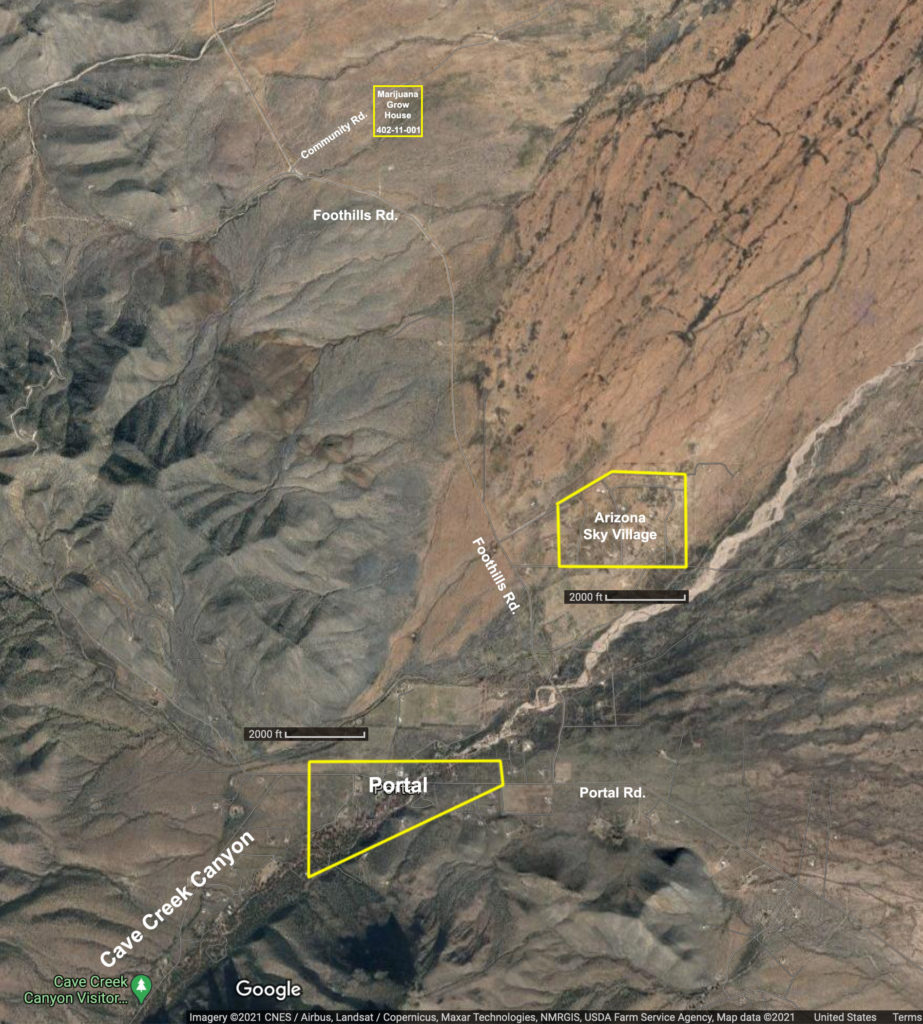
Economic damage
Portal is a retirement community of scientists and professionals. Ecotourism and service industries for locals and visitors are the basis for the economy. There is little available rental housing and no labor pool. We pay some of the highest property taxes in the county.
Portal’s scenic and biological resources draw almost 11,000 visitors annually, as documented by the US Forest Service’s Visitor Information Center. Any degradation of our natural values will strike not only at property values but at the heart of our ecotourism revenue.
This large industrial agriculture facility will damage these values and will negatively impact our ecotourism-based economy. Marijuana-grow facilities are notorious for their stench, and they produce a large quantity of solid waste from plant biomass and liquid waste from irrigation and pesticide and fungicide transport systems. The applicant appears to dismiss those issues, which are known industry-wide problems.
The facility will also greatly increase traffic and burden on our local infrastructure, while contributing little to the local economy.
This marijuana grow-op will seriously degrade property values in this area. A member of the CRC board who is a real estate agent has already seen an impact on the sales of two parcels that are on the market within two miles of the proposed facility.
Light Pollution
CRC focuses on maintaining healthy intact habitats, which includes protecting access to dark skies. Dark skies are a tangible, prime, high-dollar economic asset to Portal property owners and a major draw for international buyers. The grow-op is a major threat to the fifty-six owners of lots in Arizona Sky Village, a community of astronomers who selected this location because it is geographically well isolated from light pollution. Homeowners in this special development have invested millions of dollars in carefully designed and crafted observatories. In many cases, this equipment cost more than their houses. This value will be unrecoverable if they eventually have to sell to non-astronomers because light pollution has degraded the night skies for astronomy.
In addition to county-mandated parking and business signage lighting, a marijuana production and cash-only dispensary will require security lighting due to the nature of their product and its isolated rural location with no regular law enforcement coverage. Mr. Holmes’ application states that county lighting codes will be voluntarily observed. However, over the decades since our first county lighting codes were developed, we have had no enforcement response by the county to at least five well-documented violations that citizens have reported.
Water
CRC advocates careful land stewardship, and the dwindling Southwest aquifers are already a concern. Marijuana-grow facilities use an inordinate quantity of water, a fact that is well documented in cannabis industry publications. The proposed site is on limestone in an area where productive wells are hit and miss. Local well driller Elbrock Water Systems has had no queries from Mr. Holmes about drilling as of a few days ago, suggesting that the applicant has not even determined whether a well on the site is feasible.
The 150-gallons-a-day mentioned in the permit is a gross understatement of the amount of water actually needed in marijuana-growing facilities, regardless of the methodology used. For instance, a very similar indoor grow facility in Phoenix uses 0.07 gallons of water per square foot of grow room per day. We therefore estimate that this facility, with 9,000 square feet of grow rooms, will use 630 gallons per day for the plants alone (not counting sinks, restrooms, any landscaping, etc.).
The amount of water needed to grow cannabis in this location is actually much higher because wells in this limestone area produce hard water. Water with more than 200 ppm of total dissolved solids (TDS) damages the root systems of marijuana plants, requiring growers to use reverse osmosis systems. Reverse osmosis is 25%-10% efficient. This means that for every one gallon of soft water produced, between 4 and 10 more gallons are sent into the wastewater system.
We are concerned that Mr. Holmes has vastly underestimated the amount of water this facility will require and that he will find that this site does not have either the quality or quantity of water necessary for the operation.
Infrastructure and Public Services
The vehicles of 20-50 employees, plus the “small trucks 5000lbs or less,” plus the vehicles of customers will easily double the daily traffic on Community Road and Foothills Road – far more than what can be considered “minimal traffic impact.” Is the county prepared to double the amount of money spent on grading and maintaining these roads? Will this money come from our taxes? How will the accompanying increase in road dust be managed to prevent health impacts and accidents from reduced visibility?
The electricity needs of this facility will be substantial, and we are concerned that Mr. Holmes has not considered the lack of adequate electrical infrastructure to support this location. In fact, Columbus Electric Co-op has had no queries from Mr. Holmes about the cost of a line extension, per a member of the Board of Directors as of a few days ago. Based on reported data from similar indoor growing operations in Arizona, we calculate that this facility will use between 414,775 kilowatt-hours per month and 829,550 kilowatt-hours per month, equivalent to 473 to 946 average U.S. households. This proposed facility essentially doubles the electrical needs of the Portal area. Who will pay for the associated electrical infrastructure that will need to be installed? How will modifications to the electrical grid affect landowners in Arizona Sky Village, through whose land the lines run?
The waste generated by this facility will be substantial. Cochise County currently sends a single truck to Portal twice a week for household trash pickup, parking at the intersection of Foothills Road and Portal Road and charging homeowners $2 per bag of trash. This service is for household waste only, not commercial waste. Does Mr. Holmes expect to use this local service, and will the County need to increase the number of trucks or pickup days to accommodate this facility? Alternately, if he arranges for private waste services, the additional trucks will add further heavy vehicle traffic to the dirt roads.
Emergency Services
As the County is well aware, fire is an ever-present danger in and near the Chiricahuas. CRC is extremely concerned about the reliance of this facility on our local emergency services. Portal Rescue is an all-volunteer, community funded organization. The community raises money to support this service with events like potluck lunches. Portal Rescue is a wildland firefighting department only. This means that they do not have the equipment, training, or certification to deal with any structure fire, let alone something as potentially dangerous as this facility. Portal Rescue also does not have hazmat training or resources. The nearest fire response to this facility would be from San Simon, causing a significant delay in response time.
The National Fire Protection Association has noted a variety of factors that make indoor marijuana growing operations uniquely hazardous for fire. These hazards include
- hot 24-hour lighting systems in densely planted rooms,
- high electrical loads and dense electrical infrastructure to support lighting and ventilation,
- hazardous material storage on site for fumigation and fertilization,
- compressed gas CO2 enrichment systems, and
- security locks and barriers that reduce egress and emergency access.
Mr. Holmes is proposing installing an industrial facility requiring specialized firefighting services in an area where no fire service can respond in a reasonable time frame. We have attached an informational packet from the NFPA regarding the type of firefighting response that needs to be in place for a safe operation of this type.
In conclusion, marijuana grow operations are better suited for areas like Willcox, Sunsites, and other areas currently zoned for light industry, agriculture, and low-density housing. These areas already have the infrastructure and public services that a facility like this requires.
Chiricahua Regional Council does not oppose the other Special Use applicants’ plans you are considering. Please follow the Cochise County Comprehensive Plan, which affirms the economic importance of our region’s scenic view-shed, dark night skies, and the rural character of our open spaces.
Please deny this Special Use permit, and defend the values that draw so many tourists and settlers to this place. Thank you for the opportunity to comment.
Best regards,
Wynne Brown, President, Chiricahua Regional Council
Noel Snyder, Vice President
Eskild Petersen, Treasurer
Michele Lanan, Secretary
Alan Craig
Helen Snyder
Josiah Austin
David Hodges
Narca Moore-Craig
Dirk Sigler
About the Chiricahua Regional Council
The Chiricahua Regional Council (CRC) is a citizen’s watchdog organization, formed in the early 1990s when we enlisted the support of the entire Arizona Congressional delegation to stop a heap-leach gold mine in Portal and to withdraw Cave Creek Canyon from mineral entry. Much more recently, we worked with the Coronado National Forest to establish a 25,764-acre Zoological-Botanical Area in Cave Creek Canyon. We represent a diverse group of residents and neighbors––ranchers, scientists, writers, artists, conservationists, local entrepreneurs, and Outfitter-Guide ecotourism permittees.
Citations
Energy usage estimates: Mehboob, N., Farag, H.E. and Sawas, A.M., 2020. Energy Consumption Model for Indoor Cannabis Cultivation Facility. IEEE Open Access Journal of Power and Energy, 7, pp.222-233.
Average US household usage: https://www.eia.gov/tools/faqs/faq.php?id=97&t=3.
Average US office energy usage https://esource.bizenergyadvisor.com/article/small-and-midsize-offices
Water usage at similar facility in Phoenix: https://mjbizdaily.com/diminishing-the-drip/
Information on water hardness and cultivation: https://www.ilovegrowingmarijuana.com/best-water-marijuana-plants/
Reverse osmosis efficiency: https://premieresales.com/how-much-water-does-reverse-osmosis-waste/
Water usage per pound product: https://www.marijuanaventure.com/report-on-water-usage/
Fire hazard information: Safety Issues for Cannabis-Related Facilities. National Fire Protection Association, 2020.

